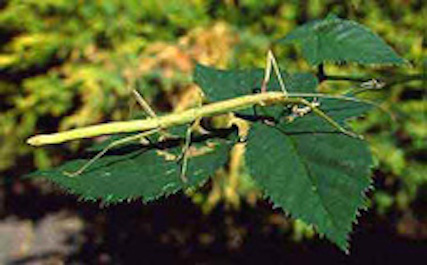These insects look like sticks or leaves.
They are very hard to see.
They have six legs.
Some have wings folded up and hidden.
Stick and leaf insects eat plants.
Stick insect on a stick ©Getty Images
Insects
Insects are invertebrates: animals without backbones.
Phasmids (say faz-mids) are insects that look like sticks or leaves. They are sometimes called 'walking sticks'. These insects have developed many unusual shapes so that their predators find it very difficult to find them.
Included in this group of insects are the longest insects in the world. There about 150 different phasmids in Australia alone. The biggest phasmid found in Australia is the Titan stick insect, which grows to about 25 cm in length.
Habitat and Distribution (where they are found)
Leaf insect. ©Getty Images
Phasmids can be found in warm places all over the world. In Australia, stick insects are found in most places, but leaf insects are only found in north Queensland.
Camouflage
Stick and leaf insects have developed the shape and colour of the leaves and twigs of plants they live on. They can change colour to match changed surroundings. If disturbed, they may sway gently like leaves or twigs in the breeze. They may drop to the ground, pull their legs to their body and remain very still, perfectly camouflaged as a stick. If grabbed by a predator, they can drop a leg, and later grow a replacement.
Stick insect with wings outstretched. ©Getty Images
Body
Phasmids have a long body, either a cylinder shape or flattened. They are often quite large and can reach a length of over 20cm. A few kinds of phasmid are wingless, but most kinds have two pairs of wings. The front wings are short and hard and form a protection over the larger and more delicate back wings. They have antennae which may be long or short. Phasmids are usually green or brown, but some have bright colours on the underside of their wings. These colours are only seen when the insect flies.
Spiny stick insect. ©Getty Images
Life Cycle
Male phasmids are usually smaller than the females and have larger wings. Depending on the species, females lay 100 - 1,000 eggs, flicking them one at a time onto the ground below. How soon the eggs hatch depends on conditions on the ground. The young, called nymphs, look like adults but do not have wings. They climb up into a tree when they hatch. They shed their skin several times as they grow. Underneath is a new, bigger, skin. This is called moulting. They do this because their skin does not grow like a mammal's skin does. It can take weeks or months for nymphs to reach adulthood, depending on the species of phasmid.
Food
©Getty Images
Phasmids are generally nocturnal, that is, active at night. They feed on the leaves of trees and shrubs. A few species eat grass. The nymphs eat the soft young leaves but the adults are able to eat the tougher leaves.
The Rarest in the World
Lord Howe Island stick insect. ©Getty Image
Probably the rarest invertebrate in the world, the Lord Howe Island stick insect, is part of a conservation program in Australia. They were thought to be extinct, but a few pairs were found on a steep, rocky sea stack near Lord Howe Island off the coast of Australia and were taken to Sydney and Melbourne for two separate breeding colonies.
The sea stack is called Ball's Rock, and has no beach for a boat to land. It has to be climbed, and there are just a few plants on it. The hunt for the stick insects was made more difficult by the fact that they are nocturnal, therefore had to be searched for at night - and there was a raging storm at the time!
Lord Howe Island stick insects are 15cm long, and they do not have wings. Very little was known about them. Numbers are slowly increasing in captivity.







